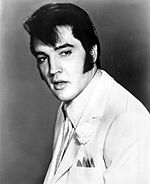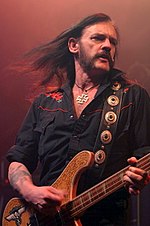Sideburns
Sideburns, sideboards,
Variations
Sideburns can be worn and grown in combination with other styles of facial hair, such as the
Indigenous men of Colombia and Mexico, including Aztecs, shaved their heads and wore their braided sideburns long, said to be wearing "balcarrotas", rarely seen in modern times, but prized in the 16th century as a mark of virile vanity and banned by the colonial authorities in New Spain, resulting in rioting in 1692.[3]
History
Following the fashion in Europe young South American criollos adopted sideburns. Many of the independence heroes of South America, including José de San Martín, Manuel Belgrano, Antonio José de Sucre, Bernardo O'Higgins, José Miguel Carrera, and Antonio Nariño had sideburns and are as such depicted on numerous paintings, coins and banknotes.
Nineteenth-century sideburns were often far more extravagant than those seen today, similar to what are now called mutton chops, but considerably more extreme. In period literature, "side whiskers" usually refers to this style, in which the whiskers hang well below the jaw line. As with beards, sideburns went quickly out of
In 1936, President
Notable 21st century examples include Emmanuel Macron, Javier Milei, Cem Özdemir, Viktor Yushchenko, David Pountney, Adam Sandler, John Lithgow and David Tennant.
Because of sideburns' multifarious history, they may be seen as stuffily Victorian; an indicator of roughness, vice, or rebelliousness;[7] a characteristic of rock 'n' roll; or merely a retro fashion revival.
See also
References
- ^ "AskOxford". Archived from the original on September 26, 2007. Retrieved 2007-06-27.
- ^ Goolrick, William K. Rebels Resurgent: Fredericksburg to Chancellorsville. p. 29.
- ^ Joaquín García Icazbalceta. "Vocabulario de mexicanismos : comprobado con ejemplos y comparado con los de otros paises hispano-americanos". Fundación Biblioteca Virtual Miguel de Cervantes. Retrieved March 1, 2013.
- ^ "President Grows crop of Sideburns: Mrs. Roosevelt Laughs Heartily as He Arrives at Campobello". The New York Times 28 July 1936. Retrieved 9 September 2008.
- ^ "Sideburns a la Presley Aren't Ivy; Dern of Penn Quits Track Rather Than Alter Appearance". The New York Times, 9 February 1957. Retrieved 9 September 2008.
- ^ "Youth With Sideburns Is Graduated in Jersey". The New York Times, 13 June 1967. Retrieved 9 September 2008.
- ISBN 978-0-922890-59-0.







